Ready, steady, GO!

The on again, off again, Spring this year has finally decided it wants to be here, rather than somewhere a lot further South. After an unseasonably warm February, March was about 2°C colder {{1}} than the 30 year average. This made meaningful inspections tricky – it was too cold to be opening hives – and largely pointless. What would a quick peek tell me that I couldn’t guesstimate from activity at the hive entrance?
The protracted cold weather meant that colonies got a fondant top-up in mid/late March to tide them over until the good weather arrived.
Which it did on Tuesday this week.
Unfortunately, I was scheduled to visit on Monday and arrived at the first apiary as the temperature reached a Baltic-feeling 9°C. Undaunted, I unloaded the car and set about a variety of activities designed to fill in time without doing too much damage; checking stacks of stored supers, arranging queen excluders, cutting back the ever-present buddleia ‘weedlings’ and periodically checking for activity at the hive entrances.
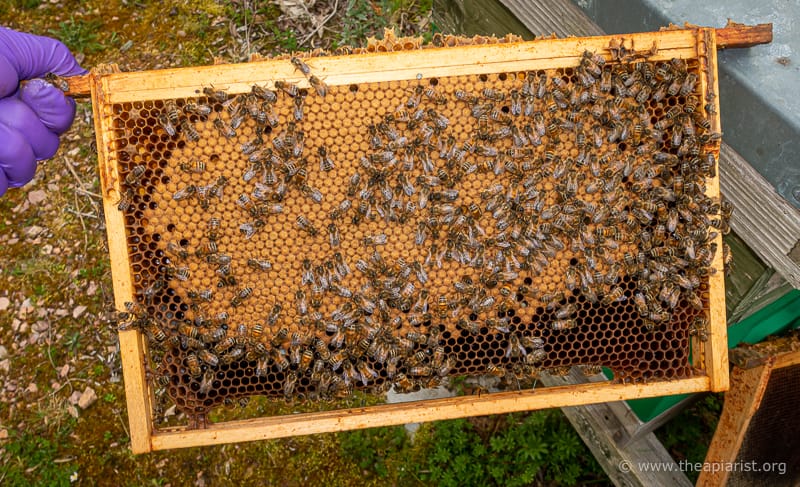
A good laying pattern
But, it wasn’t happening, so I disappeared to a coffee shop for an hour or so to read the paper and watch the world go by … and the sun finally appeared.
Ready, steady, GO! … time to check some colonies.
First impressions
The first inspection of the season is usually one for a ‘thorough overview’, though perhaps without too much detail. How does the colony look after the winter?
- Assuming it’s queen right, is it building up well?
- Does it have sufficient stores should the weather take a turn for the worse again?
- Does it have enough space to expand if the weather improves (or continues to be good)?
- Are there signs of disease?
- Is the queen clipped and marked? Typically the colony will be less strong than it will be in a month or so … it will therefore be a lot easier to find a queen from late last season that had been missed (or was a – more frequent than you might think – late season supersedure)
- And, assuming all that looks OK, perhaps consider adding the first super and guesstimate when swarming might be starting, the latter based upon the amount of drones and drone brood.
Well, I managed most of the above with the exception of marking any queens.
Every queen I saw was clipped and marked already.
Every one I didn’t see – but wanted to – was because the boxes were bursting at the seams with bees and brood.
Notwithstanding the low temperatures in March, many colonies were booming, with some on 8-9 frames of brood in all stages already.
Almost all of them needed supering … we’re off 🙂 .
Temper tantrums
Although it was sunny and reasonably warm, it wasn’t balmy. Similarly, although it looked like there was a bit of early season nectar coming in (perhaps a bit from the OSR – see below) it was still somewhat marginal conditions to have the hives open for too long.
Warm temperatures and a strong nectar flow can mask bad behaviour by a colony. They’re preoccupied with the nectar and tolerate having the roof popped off and the brood nest disturbed. Conversely, a colony with questionable temper will ‘show its true colours’ in imperfect weather conditions or during a dearth.
There certainly wasn’t a dearth, but the conditions were some way short of perfect. Fortunately, colony behaviour was reassuringly and uniformly good.
These bees are all ‘open mated’ so I have no control of the drones that contributed to their genetics (other than routinely removing drone brood from any of my own colonies routinely showing poor temper).
This either speaks volumes for the quality of the bees managed by Fife Beekeepers (and others) in neighbouring apiaries, or my skills in winnowing out poor quality stock during queen rearing.
Whilst I’d like to take all the credit, I suspect it’s a bit of both.
However, what it shows is that it is possible to readily produce well-tempered bees using a relatively crude ’rear from the best third, cull the worst third’ queen rearing strategy.
Temper, running and following
I score three behavioural characteristics – temper, running and following.
Although temper and following (those aggressive workers that target you back at the car as you remove your veil) may be linked, I’ve regularly seen bad tempered bees that don’t follow, and (albeit much less frequently) aggressive followers that appear to originate from reasonably well-tempered colonies. I therefore score them separately. I bet the genetics are distinct.
Personally I think following (or, perhaps more generally, aggression away from the hive) is totally unacceptable and I’m rigorous is replacing queens that head colonies that exhibit the trait. Not only is following a ‘PITA’ for the beekeepers, it’s also a menace for any civilians going near the colonies.
Whilst the land my bees are on is private and relatively secluded, I have no control over who wanders past and – even if they’re ’just having a look’ – would be mortified if the bees chased them off.
‘Running’ is my abbreviation for steadiness on the frames during an inspection. Bees that don’t run all over the place make inspections much easier. Whilst the genetics of aggression in bees has received some attention by scientists, I’m not aware of any studies of running.
It’s an interesting trait … some bees always show it, charging around like ‘headless chickens’, clumping on the lugs or corners of frames and dropping to the ground, obscuring the brood pattern and making finding an unmarked queen a thankless task.
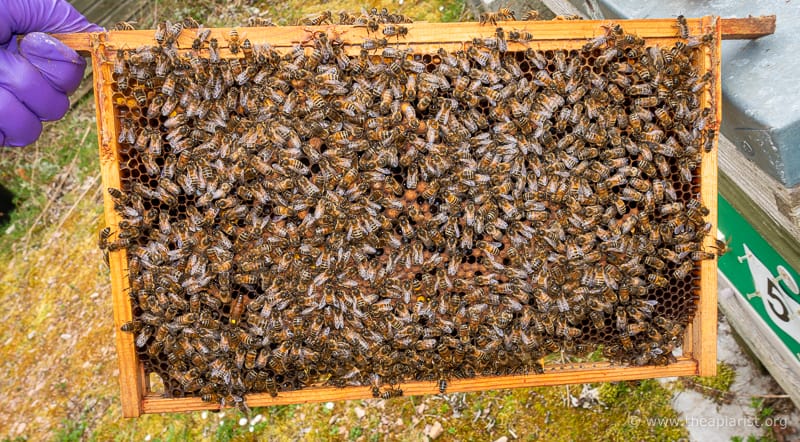
Spot the queen – easier when the bees aren’t moving
Others seem to only run about manically under certain conditions, often in a temperature or weather-dependent manner. I’ve had some colonies that were rock-steady in cool or damp conditions, but overly mobile once things warmed up. It’s also clearly influenced by over-smoking the colony, another reason to use the smoker sparingly.
Scores on the doors
All of the above are scored from 1-5 (execrable to perfect; sometimes with half points if I’m feeling pedantic), with any of them consistently scoring 4 or lower precluding them from being used for queen rearing. Similarly, any colony that consistently scores 3 or lower will be destined for queen replacement.
Like all academics, I have an aversion to using the very bottom of the marking table (have you seen the degree grade inflation? {{2}} ), so 1’s are rare and the colony has to be either psychotic or a complete blur on the frame to achieve that score.
’Consistently’ is the key word in the first paragraph of this section. Any colony can have an off day. The beekeeper might have clumsily opened the box, or inadvertently crushed a bee or two when removing the first frame, or the hive might have been a scratching post for deer … cut them some slack.
This is why record keeping is so important. Poor behaviour one week, by an otherwise exemplary colony, shouldn’t preclude it from being used to rear the next generation of queens.
Perhaps your memory is better than mine? Actually, I’m sure your memory is better than mine. However, unless you only have one colony, or can memorise Pi to 70,000 places, then learning to keep good records is a really useful skill which will improve your beekeeping.
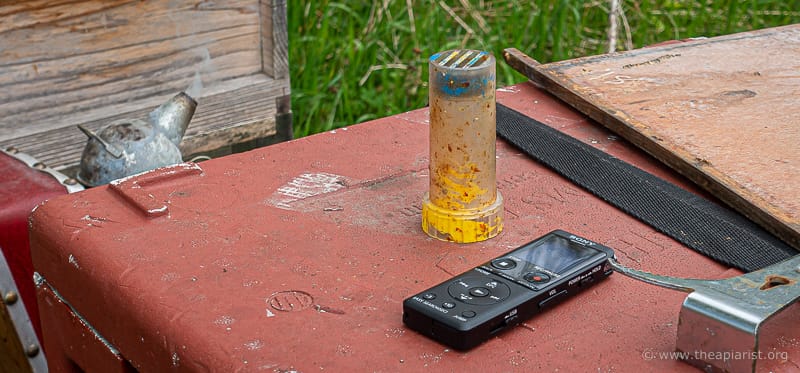
My ‘personal assistant’
Almost as useful as having more than one colony … subjectively a single colony might be bad tempered but, objectively, if one colony is (consistently) less well tempered than all the others then there’s a problem.
Little dramas
Inspections are, by definition, intrusive.
The relatively stable, temperature-controlled, pheromone-rich environment of the brood nest is upset. Bees are displaced, the 24/7 laying activity of the queen is often interrupted, stores are shifted, the ‘dance floor’ used by communicating foragers is temporarily removed, and possibly moved altogether.
Inevitably this disrupts the functioning of the colony.
But it gets worse … smoke is puffed through the size-regulated spaces between the frames of brood and stores, masking the pheromones but also triggering gorging on stores, light floods in exposing newly emerged workers to a completely alien experience, the temperature plummets.
Unsurprisingly, this level of intrusion results in changes of behaviour by the colony. The more intrusive and disruptive the inspection by the beekeeper, the more dramatic the behaviour of the colony changes.
It’s in both your and the colony’s interest to conduct the inspection with as little drama as possible. The less you disrupt them, the better you will be able to judge all of those things you’re inspecting them for in the first place.
Slow and steady, gently, little smoke, avoid crushing bees, return frames in the same order and orientation (unless there’s reason to move them) … no rushing, take your time but don’t take too long, know what you’re looking for and avoid going back through the box because you forgot something.
But inevitably you’ll be faced by events or situations that are unusual and that require attention. Some could have been be avoided perhaps, but others are only obvious once you’ve got the roof off and have started.
Here are three I experienced on Monday/Tuesday … and how they were dealt with (or should have been dealt with 🙁 ).
Brace, brace, brace
If you feed fondant to light colonies over the top bars of the frames, rather than over a hole in the crownboard, the bees can readily access the stores. That’s ‘a good thing’ … what’s the point in supplying fondant unless you make it as easy as possible for the bees to reach it?
However, it also means you have to supply ‘headspace’ over the top bars. Once the nectar starts flowing and the colony needs more space they will build brace comb up into this headspace – sometimes from the bottom up (if you’ve used a super to provide the headspace), or from the top down if you’ve used a thinner eke.
While you’re admiring the beauty of naturally drawn comb note how all the cells slope upwards (and you can read why here), irrespective of the direction it was drawn.
You can’t do much with the hive until that brace comb is removed. It’s likely it’s at least part-filled with stores or brood, and almost certainly covered with bees.
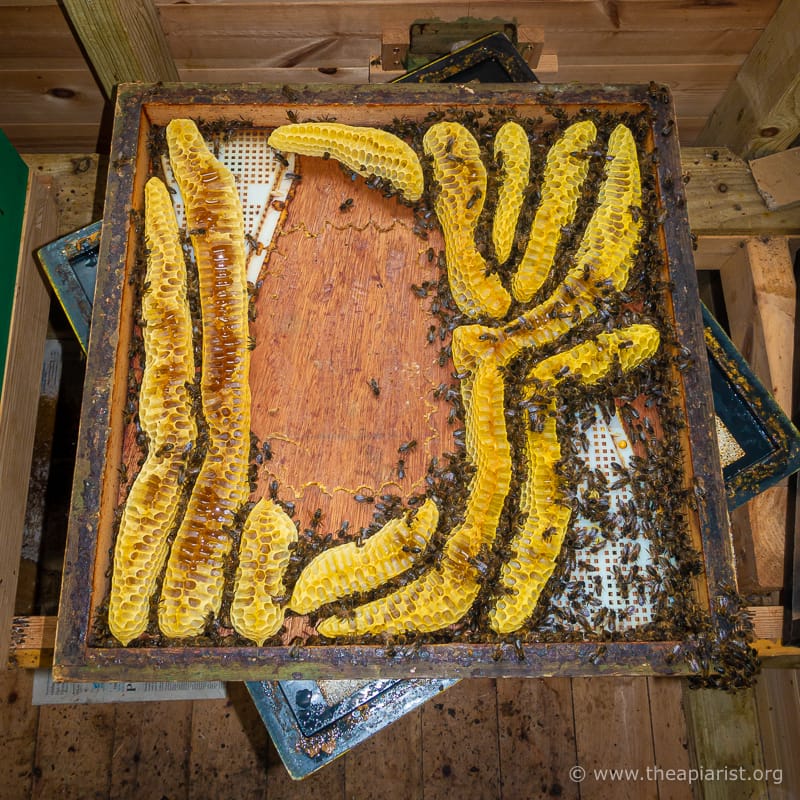
Clearer board used to provide headspace …
If the comb protrudes from the top bars you’ve got little choice but to smoke them gently and remove the brace comb using a hive tool with a sharp blade. It’s easier to do this frame by frame than to smoke the entire box and try and do it in one go.
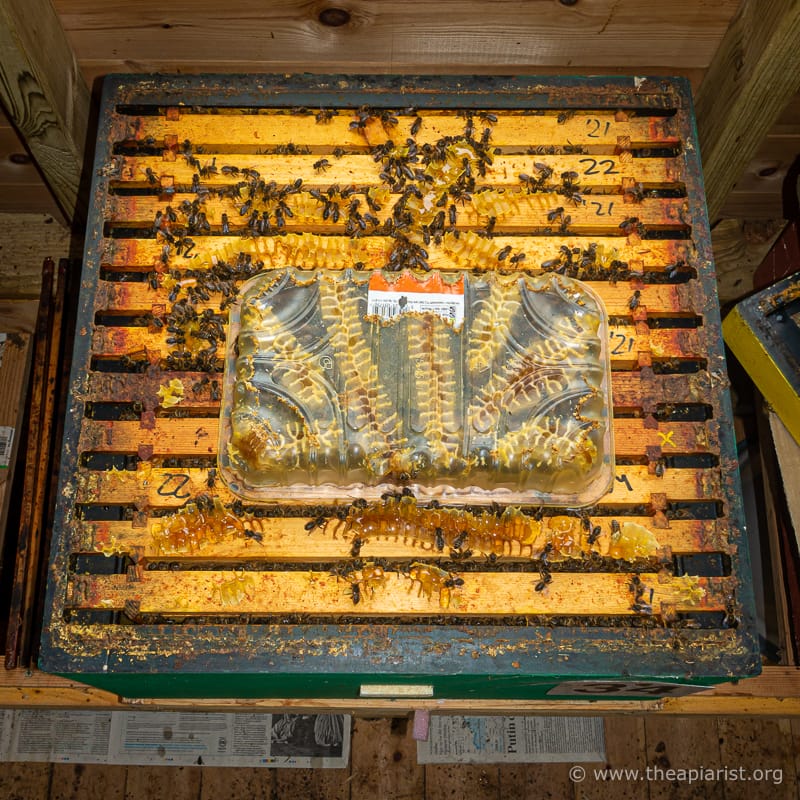
… for this block of fondant
However, if the brace comb is attached to the crownboard i.e. hanging down into the headspace, the easiest thing to do is to dust off a clearer board and reassemble the hive – brood box, clearer (or eke and clearer if your clearer doesn’t have a deep lower rim), empty super, crownboard and attached brace comb.
The following day
The following morning all the bees will have abandoned the brace comb and will be back in the brood box. By taking an extra few hours the colony is far less disturbed and you can start the inspection knowing they’ll be on their best behaviour.
If the brace comb is still full of bees it’s probably because the queen is there as well … or (less likely at this time of the season) the colony is queenless.
Almost all my colonies had varying amounts of brace comb above the top bars. Yes, I could have perhaps avoided this by timing my inspections a little better but the weather really hadn’t been good enough and/or didn’t coincide with my trips across country.
However, they can build comb remarkably fast. The strong colony shown in the photos above had started to build into the – now empty – headspace above the top bars during the 12 hours the clearer board was in use.
Getting the timing right either needs luck, or lots of visits.
Supering, queen excluders and more brace comb
A few of my colonies had 4-6 frames of brood in all stages. These probably won’t need a super for another fortnight. However, the strong colonies – of which there were a reassuringly large number – were rapidly running out of space and needed supers.
For the first time there was an obvious difference between colonies in the bee shed and those outside in the same apiary. The former were appreciably stronger. Numbers are small – only about 4 either in or outside the shed – but the pattern was consistent. However, since I’ve not always seen this in previous years it may just be chance.
Chance or not, it meant that the colonies in the shed all got at least two supers.
And, for me at least, supers mean that I have to add a queen excluder first.
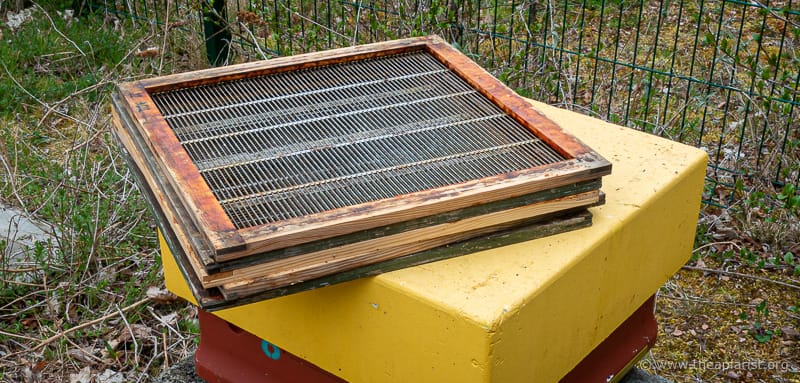
Ready for deployment – wired, framed queen excluders
Since we’re talking about not disturbing the colony too much it’s worth stating that I think that framed, wired, queen excluders (QE) are, by some long way, the best choice. With standard bottom bee space National boxes, the QE can be carefully added with little chance of crushing bees on the top bars of the frames … and usually quickly and without using any smoke. In contrast, the plastic or zinc ‘lay flat’ QE’s are much more difficult to add to the brood box.
They might cost six times as much, but I consider them a good investment. They’re also longer lasting and a lot easier to clean (just stack them in the steam wax extractor).
Wet and dry supers
The bees can be reluctant to cross the QE, at least until space is very tight in the brood box and/or there’s a strong nectar flow. One way around this is to omit the QE and only return it once the super is busy.
I don’t like doing that and it’s incompatible with my apiary visits.
Instead I ensure that the initial supers added were stored ‘wet’ i.e. straight from the extractor, without giving them back to the bees to recover the last of the honey dregs from (which are termed ‘dry’ supers).
The overpowering scent of honey is a significant encouragement to induce the bees to move up.
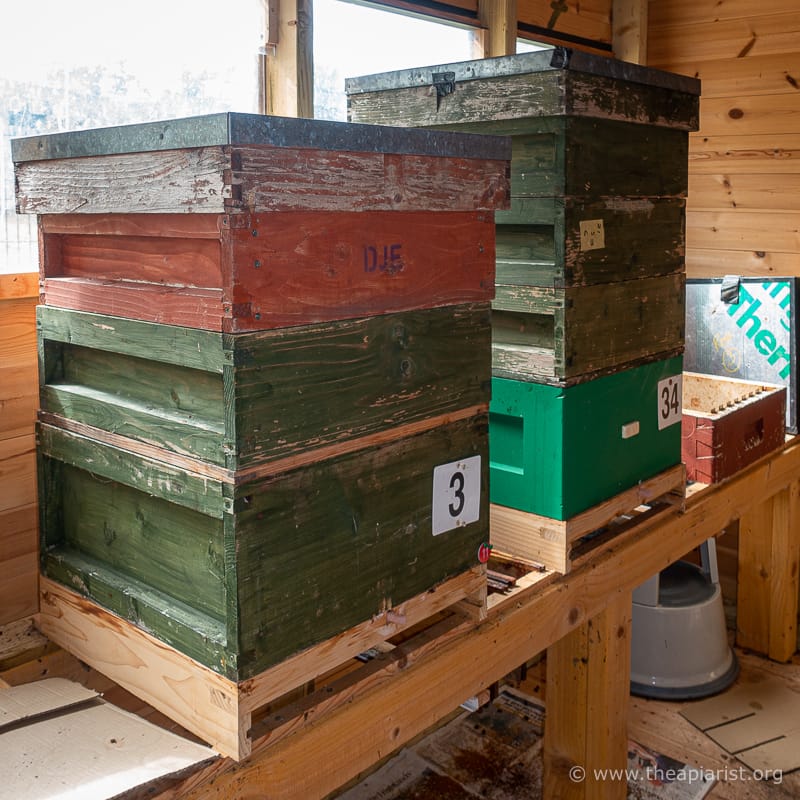
Super(s)
If I’m adding two supers at a time, which I often do to maximise space and (hopefully) delay swarming, I make sure that at least one of them is ‘wet’.
All but two colonies got a couple of supers. By my next visit the OSR will be well underway and they will definitely need the space. It was notable that some OSR fields were about 50% in flower, but others only had stragglers flowering around the margins. Is this ‘leftover’ OSR from a previous year that’s self-seeded, or do fields always start flowering from the periphery?

OSR – some full fields out, others just straggly margins (lousy photo!)
A final comment about supering and brace comb. If you are adding two together it’s unlikely those two supers were on top of each other on the last hive they adorned. Therefore, the small bits of brace comb the bees build on the opposing top and bottom bars of the super frames will, in places, occlude the bee space and may well result in crushed bees.
Ideally slice this stuff off before storing the supers, or remember to do it before using them 😉 .
Queen cells, don’t panic
There were few adult drones in the colonies, but almost all had reasonable amounts of drone brood. Swarming is still a little way off.
However, one colony had two oversized queen cells on one frame.
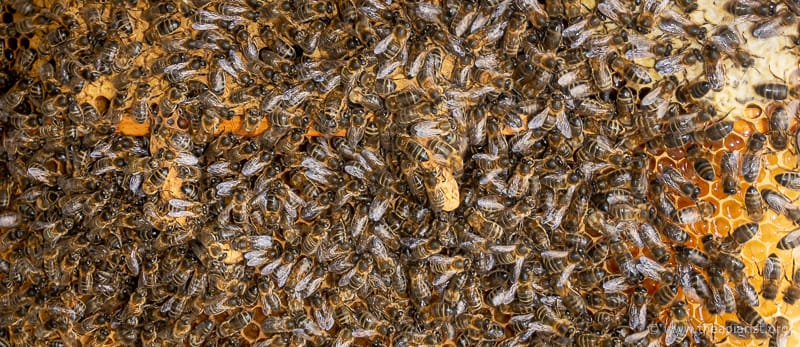
Freakishly large queen cells
This posed a dilemma … the cells were spectacularly large, almost freakishly so, and I was concerned they were possibly aberrant. What’s more, with very few drones about, queen mating was likely to be delayed or sub-optimal.
Having noted which frame the cells were on I ”ummed and aahed” about what to do while looking through the rest of the box.
Two frames later I found the queen … clipped, marked, laying OK and looking, well, regal. Not wanting to misplace her I put her frame in an empty brood box on an upturned roof and finished looking through the box.
No more queen cells … and by then I’d decided I would ’risk it for the biscuit’ by destroying the queen cells and hope the colony didn’t decide to do anything rash until my next visit when queen mating prospects would be much improved.
And, almost immediately after I squidged the queen cells {{3}}, things started to go ’pear shaped’ 🙁 .
Don’t do this at home
I went to retrieve the frame with the queen and found that she was no longer on it … she’d fallen off the frame and was now on the inside of the upturned roof, together with a couple of workers.
That perhaps should have been a clue.
I gently picked her up on the end of my hive tool and rested it on the top bar of one of the frames in the brood box. It’s worth noting that this colony was strong, but very well tempered. I’d used very little smoke when inspecting them and they didn’t seem disturbed in the slightest.
She ambled back and forth for a minute along the top bar, seemingly reluctant to enter a seam of bees. A few workers appeared and clustered around her, one or two offering to feed her. Lots of attenation occurred … nothing much to worry about, other than her apparent reluctance to move into the body of the colony.
Do bees have elbows?
Whatever, after a minute or two, a determined-looking worker elbowed her way through the little circle of bees surrounding the queen, grabbed her head, arched her abdomen around and attempted to sting her. The queen staggered off – though whether this was from being in a headlock or after being stung was unclear – into the gap between the frame lugs. More bees gathered around, though it still looked as though only one was being aggressive … and they disappeared out of sight between the frames.
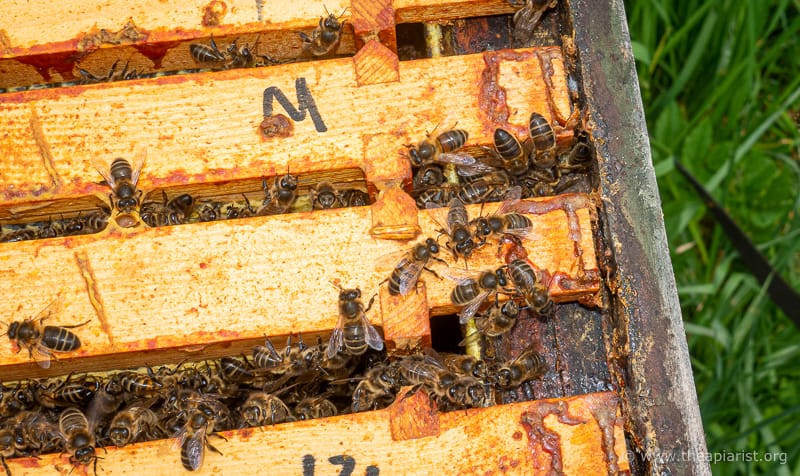
Somewhere in there it’s getting ugly
To be continued 😉 .
This wasn’t classic ‘balling’ of the queen. It only looked as though one worker was hell bent on committing regicide.
However, one or one hundred, the outcome does not look promising.
What should I have done instead?
You should always avoid suddenly introducing a queen in a situation where the colony isn’t expecting her. That’s why I allowed her to walk off the hive tool onto the frame top bars. It’s essentially the same way I (almost invariably successfully) allow queens to re-enter the hive after clipping and marking them.
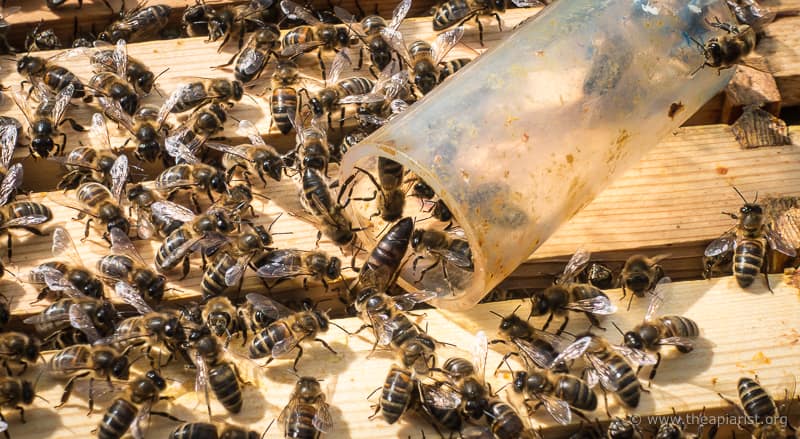
Returning a marked and clipped queen
I should have probably first placed her back on the frame she had come from, though the fact that she’d only been accompanied by a couple of workers might well mean they wouldn’t have been any more receptive to her. What’s more, it would have involved handling the frame with one hand and the queen with the other {{4}}.
Lots of opportunities for this ham-fisted beekeeper to make a mistake.
Or better still …
Alternatively, the belt and braces approach would have been to place her in a queen cage, block the entrance with candy, and allow the bees to release where when they were good and ready.
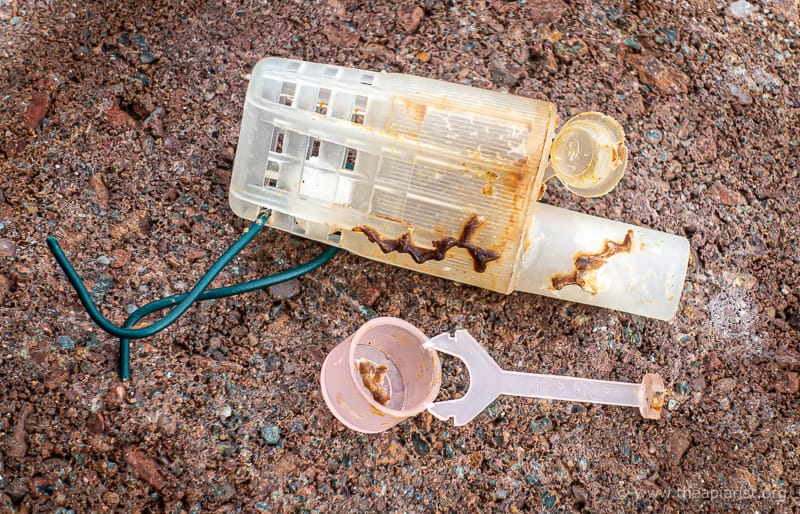
JzBz queen introduction and shipping cage
This works dependably as long as the bees are not aggressive to the caged queen … if they are they can munch through the candy and then slaughter her.
It doesn’t take long 🙁 .
When I use a queen cage to introduce a queen I always leave it with the entrance tube capped until the colony stops showing aggression to the queen. I then remove the cap, add the candy plug and return the cage to the hive. But that takes an extra day or two … .
However, under the circumstances, it’s only in retrospect I’d have ever considered caging her. She’d only been out of the hive for a few minutes, she was a laying queen and there was no real reason to suspect the colony might reject her.
If the queen is a goner there will be near mature queen cells in the hive on my next visit. I’m confident they’ll choose good larvae for a replacement, so will knock back all but one and hope she mates well.
Or perhaps she survived …
Please support further articles by becoming a supporter or funding the caffeine that fuels my late night writing ...

Thank you
Phenology update
First cuckoo of the year this morning (21/4/23), perhaps a day or two later than normal, but a day or two earlier than expected 🙂
{{1}}: Both mean and maximum daily temperatures; based upon the nearest personal weather station to my apiaries.
{{2}}: Since I graduated, obviously!
{{3}}: Their contents looked OK.
{{4}}: Not another as I originally wrote – although useful, I only have two.
Join the discussion ...